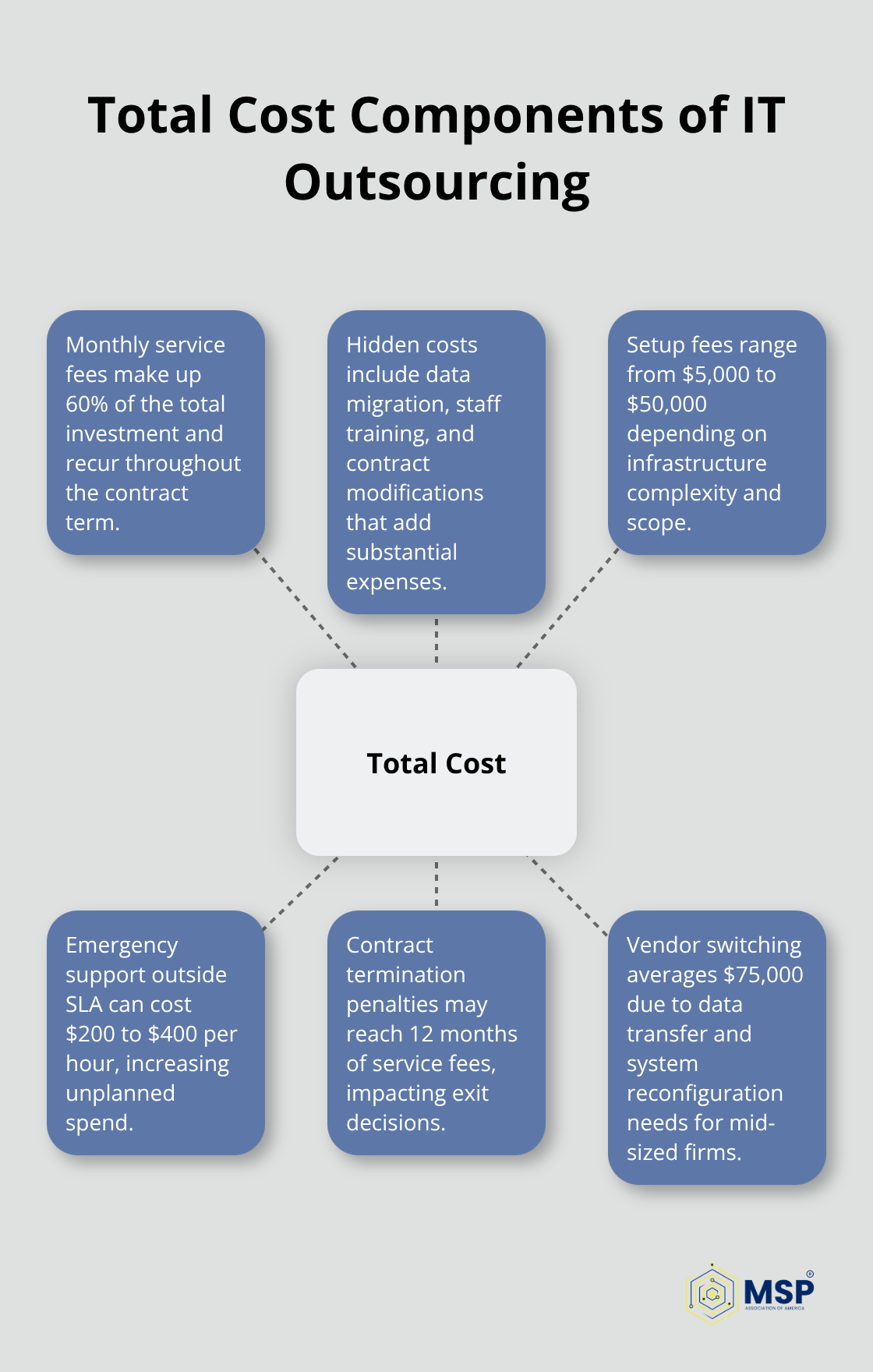How to Choose IT Infrastructure Outsourcing Services
Businesses spend an average of 6.2% of their revenue on IT infrastructure, yet 73% struggle with managing these systems internally. IT infrastructure outsourcing services offer a solution that can reduce costs by up to 40% while improving system reliability.
What Infrastructure Services Can You Outsource
Infrastructure outsourcing covers server management, network operations, data center services, and help desk support. Companies outsource application development, cloud infrastructure management, and data center operations according to Computer Economics research. Help desk services achieve the highest cost success rate at 91%, while desktop support follows at 83%.

These mature service areas deliver predictable outcomes and substantial cost reductions.
Cloud Infrastructure Leads Modern Outsourcing
Cloud services represent the fastest-growing outsourcing segment, with software outsourcing projected to grow at 11.5% annually through 2025. Organizations save up to 72% on cloud services through strategic pricing models and proper resource management. Amazon Web Services data shows that effective cloud resource tagging and automation tools like AWS Config reduce operational overhead significantly. Companies that move to cloud-first strategies report improved scalability and reduced infrastructure complexity compared to traditional on-premise setups.
Service Level Agreements Define Success Metrics
Performance metrics should focus on uptime guarantees, response times, and resolution speeds rather than generic availability promises. Effective SLAs specify uptime guarantees, 15-minute response times for critical issues, and 4-hour resolution targets for major incidents. Outcome-based contracts tied to measurable results (like customer satisfaction scores and system performance benchmarks) deliver better value than hourly billing models. Companies that achieve 85% success rates in outsourcing prioritize clear performance indicators and regular vendor accountability reviews over cost-cutting alone.
Hybrid Models Offer Maximum Flexibility
Hybrid outsourcing models allow companies to scale resources based on project needs while maintaining control over sensitive operations. Organizations can keep core systems in-house while outsourcing specialized functions like cybersecurity monitoring or backup management. This approach provides cost optimization without complete dependency on external providers. Access to high-quality tech talent that mitigates company risks becomes crucial when selecting providers for specialized functions. The selection criteria for your ideal provider will determine which combination of services delivers the best results for your specific business requirements.
What Makes a Provider Worth Your Investment
Technical certifications separate competent providers from pretenders who promise expertise they cannot deliver. Look for SOC 2 compliance, which demonstrates operational excellence and security commitment according to industry standards. ISO 27001 certification proves systematic information security management, while cloud-specific credentials like AWS Advanced Consulting Partner or Microsoft Gold Partner status indicate deep platform expertise. Providers without these certifications lack the structured processes needed for enterprise-grade service delivery. Companies that prioritize certified partners achieve higher success rates in outsourcing engagements compared to those selecting based on price alone.
Security Standards Cannot Be Negotiated
Cybersecurity ranks among the most outsourced functions in 2024, with organizations increasingly choosing third-party services due to rising cyber threats. Your provider must demonstrate GDPR and HIPAA compliance capabilities, especially if you handle sensitive customer data. Ask specific questions about their incident response procedures, data encryption protocols, and backup recovery testing schedules.

Providers invest heavily in threat intelligence and cutting-edge technologies, allowing them to detect and respond to new types of attacks. The average cost of a data breach reaches $4.88 million by 2024, making security expertise non-negotiable rather than optional.
Scalability Determines Long-Term Partnership Success
Flexible outsourcing models enable companies to adjust IT services based on demand without staffing complexities. Evaluate providers based on their ability to scale resources up or down within 48 hours during peak business periods or system migrations. Nearshore partners in Latin America offer 50% cost savings compared to US-based teams while providing better communication and cultural alignment than offshore alternatives. Providers who offer outcome-based pricing models tied to performance metrics deliver better value than those charging hourly rates without accountability measures.
Industry Experience Validates Provider Claims
Providers with industry-specific experience understand unique compliance requirements and workflow challenges that generic IT companies miss. Healthcare organizations need partners familiar with HIPAA regulations, while financial services require SOX compliance expertise. Ask potential providers for client references within your industry and request case studies that demonstrate successful implementations. Companies that choose providers with relevant sector experience report 40% fewer implementation delays and smoother transitions compared to those selecting generalist providers.
The financial investment you make in infrastructure outsourcing extends far beyond monthly service fees, which makes understanding the complete cost structure essential for accurate budget planning.
What Will IT Outsourcing Really Cost You
Monthly service fees represent just 60% of your total outsourcing investment. Hidden costs like data migration, staff training, and contract modifications add substantial expenses that catch businesses off guard. Setup fees range from $5,000 to $50,000 depending on infrastructure complexity. Emergency support calls outside standard SLA coverage cost $200 to $400 per hour according to Computer Economics research. Contract termination penalties can reach 12 months of service fees, and vendor switching costs average $75,000 for mid-sized companies due to data transfer requirements and system reconfiguration needs.

Total Ownership Costs Extend Beyond Service Contracts
Your complete financial commitment includes internal management overhead, which typically consumes 15% of your IT staff time for vendor coordination and performance monitoring. Compliance audit costs, security assessments, and integration expenses can add 25% to your annual outsourcing budget. Companies save 30% to 50% through nearshore providers compared to US-based alternatives, but must account for additional project management and communication tools. The global average spend per employee on IT outsourcing reaches $156.92 in 2025 according to Statista (making accurate cost projections critical for budget planning).
Setup and Migration Expenses Hit Hard Initially
Data migration projects consume significant resources during the first 90 days of any outsourcing engagement. Legacy system integration requires specialized expertise that providers charge at premium rates of $150 to $300 per hour. Staff retraining programs cost an average of $2,500 per employee when transitioning to new platforms or processes. Network reconfiguration and security protocol updates add another $10,000 to $25,000 in one-time expenses for most mid-sized organizations.
Productivity Gains Justify Higher Initial Investment
Organizations achieve 85% success rates in meeting or exceeding service levels through strategic outsourcing partnerships, which translates to measurable business improvements. Companies report 40% faster project completion times and 60% reduction in system downtime when working with certified providers who maintain proper staffing levels. Focus on outcome-based metrics like reduced help desk tickets, faster application deployment, and improved user satisfaction scores rather than cost savings alone. Businesses that leverage AI and automation through outsourced cybersecurity save an average of $2.22 million on data breaches compared to those who manage security internally (demonstrating that quality providers deliver returns that far exceed their service fees).
Final Thoughts
IT infrastructure outsourcing services demand systematic evaluation rather than rushed decisions based on price alone. Create a detailed requirements document that outlines your technical needs, compliance requirements, and performance expectations. Request detailed proposals from at least three certified providers and compare their technical capabilities, security protocols, and industry experience.
Avoid providers who cannot demonstrate relevant certifications, refuse to provide client references, or offer prices significantly below market rates. Companies that charge 40% less than competitors often cut corners on security, staffing, or support quality. Red flags include vague SLA terms, no clear escalation procedures, and reluctance to discuss data protection measures.
Implementation success depends on thorough planning and clear communication protocols. Establish project timelines with specific milestones, assign dedicated points of contact from both teams, and schedule weekly progress reviews during the first 90 days (document all processes and maintain backup plans for critical systems during the transition period). Visit MSP Association of America® to access our network of certified providers who can transform your technology infrastructure while delivering measurable business results.

